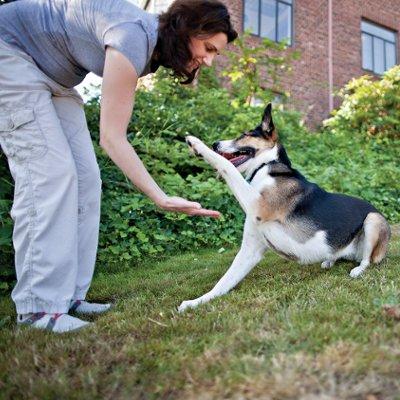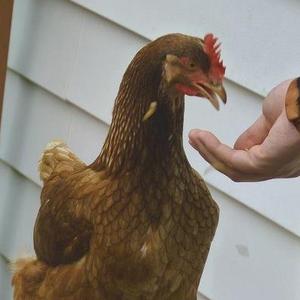Michelle Mullins and I are in the process of doing some continuing education to hone our clicker training skills. Filled with more enthusiasm and excitement than we have on Christmas morning, we jumped right in. We are fortunate that we both have a consistent yearning for education, so having the opportunity to gain knowledge about how animals learn AND have the opportunity to teach animals to do new things sounded like something we just had to be a part of.
Although filled with enthusiasm, we had our jitters. This was kind of like going back to school! It’s been at least a few years since either one of us took an exam, so the night before it all began, we dreamt about “Oh gosh, I need to study!” Little did we know that it wasn’t the exams or studying we should worry about it—it’s training something other than what we’re used to (dogs and husbands) in brand new environments.
It's easy to train Sadie-- even in the woods!
 Michelle and I love all animals equally, but most of our experience has been with dogs. We knew we needed to train another species as part of the continuing education, so we were off to do it. Michelle, clearly the braver one, ventured out and bought herself a mouse. She had a great habitat set up, lots of love to give, and a clicker and treats ready to go. Plans were altered when her brand new mouse said “Mmm… I think I’ll hide in here for… well… forever”. Michelle felt broken up with—like the mouse didn’t love her. (Insert Taylor Swift’s “We are Never Ever Getting Back Together”) (Just kidding, Michelle doesn’t take it personally. She knows the mouse is just fearful)
Michelle and I love all animals equally, but most of our experience has been with dogs. We knew we needed to train another species as part of the continuing education, so we were off to do it. Michelle, clearly the braver one, ventured out and bought herself a mouse. She had a great habitat set up, lots of love to give, and a clicker and treats ready to go. Plans were altered when her brand new mouse said “Mmm… I think I’ll hide in here for… well… forever”. Michelle felt broken up with—like the mouse didn’t love her. (Insert Taylor Swift’s “We are Never Ever Getting Back Together”) (Just kidding, Michelle doesn’t take it personally. She knows the mouse is just fearful)
 Oh no! How can you train a mouse that won’t come out to do a trick in this short allotment of time that we have? The answer? You can’t. You have to wait for the mouse to be ready to train. That meant, for the time being,
Oh no! How can you train a mouse that won’t come out to do a trick in this short allotment of time that we have? The answer? You can’t. You have to wait for the mouse to be ready to train. That meant, for the time being,
Michelle was in need of another species. Me—I’m the less brave one. I travel a lot, so adding a new species to my life wasn’t an option at this time. Thankfully, I have an excellent relationship with one of our local rescues who graciously let me and Michelle (who was desperate for an animal that was ready to learn) come train some of their cats. “Here you go—here’s the cat room”, said the local rescue.
Oh boy. Michelle and I needed to train 2 cats, who lived with about 10 other cats. All the cats were neighbors to the barking dogs. Volunteers wandered in and out often. Yikes. Fantastic rescue. Not a great place to train. Michelle managed to get a small wave from one of the cats. I managed to train a “sit” with another. I can’t say the results were monumental, but given the circumstances, I’ll take it.
So great tale, right? Two unfortunate dog trainers struggling to train another species? What’s the moral story of it all? Sometimes as a trainer, I can overlook and take for granted some of the very basics of training- my animal and the environment.
Training requires willing participants and trainers sometimes need to be prepared to wait. Just because you’re wearing your treat pouch filled with treats and a clicker in hand, it doesn’t mean you’re about to train a “roll-over”. Sometimes all that training session will amount to is providing treats to let your animal know “Hey, if you’re interested, I’ve got some treats that you might want to come out for”. And that’s success and you shouldn’t really expect more.
In the case of Michelle’s mouse, Michelle already has long-term plans of how she’s going to make her mouse more comfortable so that, one day, maybe the mouse will be ready to learn to jump through hoops. Also, environment. Personally, I can take advantage of my kid-free, single-species, husband-that-works-a-lot quiet household to train in. Today I was reminded that that environment that I take for granted is something I should be grateful for and should be something I take time to prepare before every training session. My next training session with the rescue cat will be in a quieter environment. I’m confident I can train her to sit, look cute, and put on the “Please adopt me…” face.
Sadie has that face down perfectly!
 Training is a multi-factor event. A lot goes into it. It is those that consider all of the factors—supplies, the animal, the environment, etc—that are truly successful.
Training is a multi-factor event. A lot goes into it. It is those that consider all of the factors—supplies, the animal, the environment, etc—that are truly successful.







